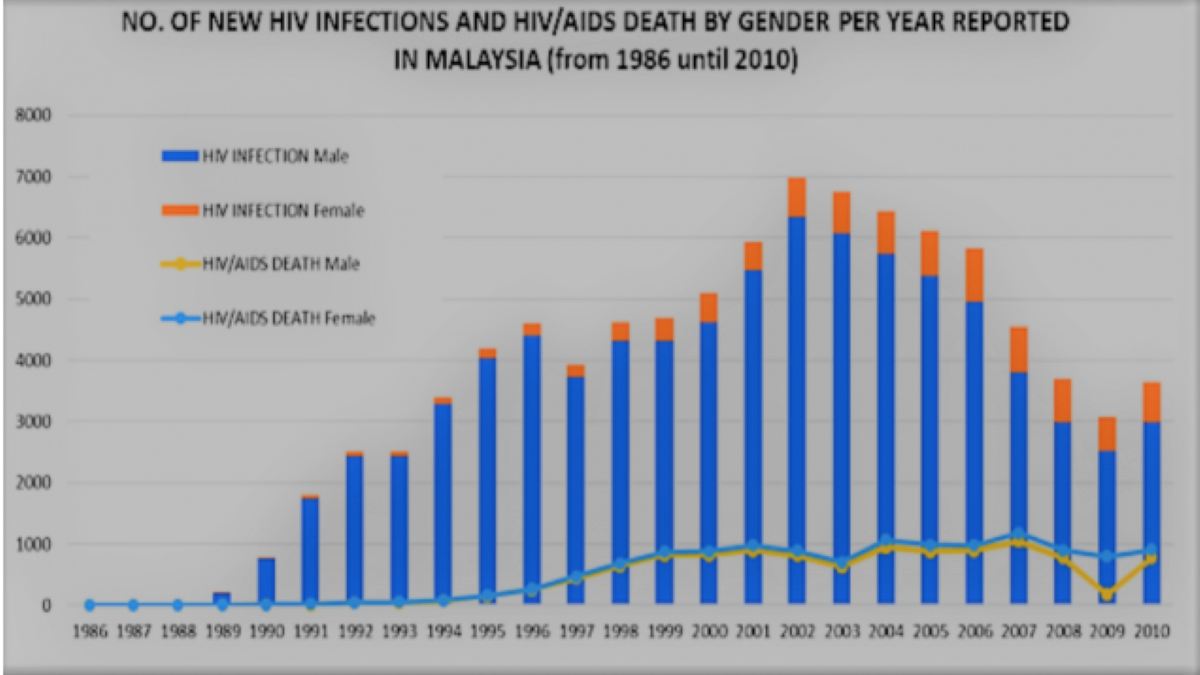Malaysia Population Research Hub

Data from the Ministry of Health showed that by end of 1994 there were 3,393 cases of HIV, 105 cases of AIDS and 80 cases of AIDS death. In 1996, the Government announced that some 300 new HIV cases were reported each month, bringing the cumulative total of HIV and AIDS cases to about 16,349 and 448 respectively by middle of that year. The situation has gotten worse, such that by June 2006, the number of HIV cases recorded by the Ministry of Health had increased to 73,427 of which 11,413 had progressed to AIDS. Another 8,703 patients have died from the disease. The majority of HIV-infected individuals in Malaysia, nearly 79 per cent, were between the ages of 20 and 39, while some 1.4 per cent of those infected are aged 13 to 19. Men made up the bulk of new HIV cases, with only about 1 in every 10 new cases occurring among women.
Estimates by UNAIDS show that the number of adults and children (ages 15+) living with HIV/AIDS increased more than 10-fold to about 69,000 persons by 2006; with a prevalence rate of about 0.5 per cent (Table 1). While the overall level is still relatively low in Malaysia as compared to 1.0 per cent for the world as a whole, the rapid rise is Cause for concern.
Table 1 : General HIV/AIDS Situation in Malaysia, end 2005
| Adult (ages 15+) HIV prevalence rate (range: 0.2-1.596) | 0.5 |
| Mother-to-child transmission, Estimated number of people (all ages) living with HIV (range: 33,000-220,000) | 69,000 |
| Mother to-child transmission, Estimated number of women (ages 15 ) living with HIV (range: 7,300-57,000 | 17,000 |
| Percentage of pregnant women receiving treatment to reduce mother: to-child transmission | 6.1 |
| Percentage of HIV-infected women and men receiving antiretroviral therapy | 27.0 |
| Orphans, children (ages 0-17 years) orphaned due to all causes, estimate | 480,000 |
| Adults aged 15 and over living with HIV (range: 32,000-220,000) | 67,000 |
| Deaths due to AIDS (range: 2,10 | 4,000 |
In Malaysia, the most common risk factor for HIV infection was exposure to contaminated drug injecting equipment (which accounted for three in four HIV infections in 2002, most of them were men, aged 20-40 years) (UNAIDS, 2006). Available information indicates that a small but growing proportion of new HIV infections is attributable to unsafe sex, much of it between current or former injecting drug users, their sexual partners and sex workers (Ministry of Health Malaysia and WHO, 2004).
The Ministry of Health and the Malaysian AIDS Council (MAC), in collaboration with other NGOs are carrying out educational campaigns to control the spread of this pandemic. To increase the awareness of HIV/AIDS, the MAC has collaborated with the Ministry of Women, Family and Community Development to commemorate the International AIDS Memorial Day 2004 with the theme Women and HIV/AIDS”to lay the ground work for combating this scourge from women’s perspective. As a result of continuous campaigns from the government, this can be said that 95.5 per cent of adolescent (ages 13-24) had ever heard of HIV/AIDS (Table 2).
Table 2 : Percentage of Adolescent (ages 13-24) Had Ever Heard of HIV/AIDS by Sex
| Male | Female | Total | |
| Ever Heard | 95.0 | 95.9 | 95.5 |
| Never Heard | 5.0 | 4.1 | 4.5 |
| Total | 100.0 | 100.0 | 100.0 |
In 2001, there were a total of 723 public/NGO sites offering PMTCT services, and they were able to cover 100 per cent of population in need of such services. However, only a small proportion of those in need of VCT, ARV and antiretroviral therapy services had received such services (see Table 3).
Table : Access to Care and Treatment For HIV/AIDS, Malaysia, 2001
| Indicator | Number/Per Cent |
| Population in need that received VCT services (est: %) | 11 |
| Number of clients receiving public/NGOVCT services | 2,260 |
| Number of oublic/NGO. VCT sites | 120 |
| Population in need that received PMICT services (est. %) | 100 |
| Number of clients receiving public/NGO PMICT services | 1,409,537 |
| Number of public/NGO sites offering PMTCT services | 723 |
| Population in need that received AV treatment (est %) | 22 |
| Number of clients currently provided with antiretroviral therapy by the public/NGO sector | 1,100 |
| Number of public/NGO sites offering antiretroviral therapy services | 20 |
| Adult population in need that received cottimoxazole prophylaxis (est. %) | 67 |
| Adult population in need that received TB treatment with DOTS (est. %) | 74 |
| Number of patients receivina DOTS | 15,057 |
Download : PopInfo Issue 1 2007